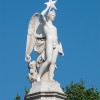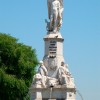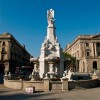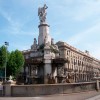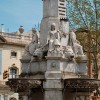Fountain of the Catalan Genious, the Marquis of Campo Sagrado
Pla de Palau
Sculpture: Fausto Baratta, Josep Anicet Santigosa, restoration Frederic Marès
Architect: Francesc Daniel Molina, signed
Materials: White marble
Inauguration: June 1, 1856
On June 1, 1856 the Pla de Palau la Fuente the Catalan genius was inaugurated as a tribute to Captain General José Bernaldo de Quiros, Marquis de Campo Sagrado, who promoted the bringing of water Moncada in years of severe drought. Therefore, the noble coat of arms of the Marquis figure prominently in the monument with the inscription: "After God, the house of Quirós." The project of the monument is the architect Francesc Daniel Molina and statues were made by the brothers Leopoldo di Baratta, Italian marmolistas then working in Barcelona. The four side statues symbolize the four Catalan provinces and the four lion heads gushing water at the mouth, the Llobregat, Ter, Segre and Ebro rivers. The figure dominates the monument and gives it its name represents the Catalan genius, and some authors say it is not the work of the Baratta brothers, but Santigosa José Aniceto, who had already intervened a few years earlier column dedicated to Galceran Marquet. Initially it was made completely naked. But a few days after the inauguration, and that, says Puig and Alfonso, "they were women in procession made taking views of the kindness of forms of this statue," the bishop of the diocese intervened with the authorities and upright again scaffolding removed shortly before, castrated with a hammer and hastily had to improvise a list of draping that for more than a century and a half, he covered the sin of the statue. After the Civil War, the fountain was repaired by the sculptor Frederic Marès, who added a few pieces that had broken wings, feet, hands and palm star and that these hold, but keep the púdico loincloth. This was removed in the mid-eighties, and came into view the mutilated crotch genius, only with testicles, until, at the beginning of the nineties, a restoration promoted by the Municipal Campaign for the Protection and Improvement Cityscape adding, as a prosthesis, a penis that looked like a tube, made of resin by a stonemason. Also, also they replaced with resins parties Marès had rebuilt after the war and who had separated from the main block by the action of the elements. All these resins were finally removed in a very rigorous restoration carried out between 2007 and 2008 by a team of six restorers led by Merce Marques. The new modeling pieces of figures occupied by withdrawals resins and someone else had not replenished in some serious reform of 1990 was carried out faithfully from old photographs, by Abel Vallhonesta and realization in marble from modeling, and its fixation in the figures was the work of sculptor Fernando Regàs. those parts that had remade Marès different to the original way, like the wings of the horses that had initially been like butterfly respected.
In the difficult discussion about what to do with the gelding's penis genius, it was decided to withdraw the addition of 1990 and leave it, as the Hermes of Praxiteles, which has similar to those of genius proportions, since it is not available any drawing the original work and it is impossible to know, therefore, what shape and size had granted sculptors create it. Any incorporation into that place would be as imaginative and disrespectfully as exhibited from 1990 to 2007.
Also, the municipal department of Architecture and Urban Projects, responsible for the restoration, made a clean fungi and replaced the water system. New were also made in bronze letters a plaque to Marqués de Campo Sagrado.
Despite the impressive recovery work, the monument is a work hard hit by the passing years and perhaps someday will consider whether to take the museum and replace it with a new copy.
-
Barceloneta - Pla de Palau
-
Metro
L4 BARCELONETA




